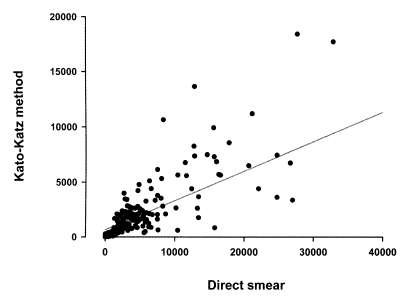Correlation of egg counts of Clonorchis sinensis by three methods of fecal examination
Article information
Abstract
The Kato-Katz (KK) method is a well-known method of fecal examination for helminthiases. Its diagnostic sensitivity was found very high for clonorchiasis. The present study evaluated the correlation of Clonorchis sinensis egg counts by the KK method with those by direct smear and formalin-ether (FE) technique. The egg counts obtained by the KK method (Y) were correlated with the counts by direct smear (X) with the equation of Y = 659.4 + 0.266X (r2 = 0.738), but not with those by the FE method. The present study demonstrated that the KK method and direct smear were useful for both qualitative and quantitative diagnosis of clonorchiasis, especially in the field.
The Kato thick smear technique was originally designed for mass screening of ascariasis or other helminthiases, but is satisfactory only for qualitative diagnosis (Beaver et al., 1984). For simultaneous qualitative and quantitative examination of helminthiasis, the Kato-Katz (KK) method was developed by modification of Kato thick smear, which uses a calibrated plastic or cardboard template to contain a consistent volume of fecal sample (Beaver et al., 1984). The KK method had been shown to be better than Stoll's dilution egg counting technique for quantitative analysis of intestinal helminthiases (Hong et al., 1992). Therefore, the KK method is useful for both qualitative and quantitative analysis, and is preferred for counting helminth eggs in feces, especially in the field (Odongo-Aginya et al., 1995). Recently, we found that the KK method is a highly reliable diagnostic method for clonorchiasis compared to formalin-ether technique (FE) and direct smear (Hong et al., 2003). The KK method showed diagnostic sensitivity of 98.9%, which was the highest rate ever recorded, and was sensitive even in lightly infected cases of clonorchiasis.
The KK method and direct smear are the only techniques that can be used for both qualitative and quantitative diagnosis of helminthiases (Beaver et al., 1984). The combination of KK method with direct smear resulted in increase of diagnostic sensitivity, especially in the infections of Schistosoma mansoni and hookworms (Engels et al., 1996). However, the correlation of EPGs obtained by both methods was not described in detail.
The present study analyzed the data of our previous report (Hong et al., 2003) to evaluate the correlation of egg counts per gram of feces (EPG) determined by the KK method with those estimated by the FE method or direct smear. Briefly, 300 residents from an endemic area of clonorchiasis in Heilongjiang, China, were screened for C. sinensis infection by a single KK smear. An experienced technician examined each fecal specimen by reading 3 KK, 3 FE, and 6 direct smears per specimen. Among 300 subjects, 27 residents were negative for C. sinensis eggs; therefore, EPGs of 273 people were calculated, and analyzed for the evaluation of correlations of EPGs among three stool examinations.
All three methods could count numbers of eggs of C. sinensis but the range of egg counts was variable, and became wider when the EPG counts increased. The average EPGs of 273 egg positive residents were 0-36,488 by KK method, 0.3-3,887 by FE method, and 0-181,750 by direct smear, respectively. The egg counts by the KK method (Y) were correlated with the counts by direct smear (X) with the equation of Y = 659.4 + 0.266X (r2 = 0.738) (Fig. 1), but not correlated with those by the FE method.

Frequency distribution of eggs per gram of feces (EPG) determined by Kato-Katz method against EPGs by direct smear. A linear regression curve is plotted in the graph.
The KK method is widely used to estimate EPGs for routine quantitative diagnosis in helminthiases. It produces a consistent smear of 41.7 mg of feces, and egg counts on one smear are converted to EPG by multiplying a constant 24 (Ebrahim et al., 1997). Due to the disadvantage of requiring a clearing time of several hours, a quick variant method has been developed, which uses a stainless steal template capable of delivering 20 mg of stools (Peters et al., 1980). The "quick and thin" KK smear is easy to prepare specimen and make it cleared rapidly (15 min.), and the egg counts were proportional to those obtained by the classical KK smear (Peters et al., 1980). A glass coverslip modification was also proposed to allow an immediate examination of a smear (Teesdale and Amin, 1976a, 1976b; Teesdale et al., 1985).
Direct smear is estimated to contain about 2 mg of feces, and EPG can be calculated by multiplying eggs per smear by 500 (Beaver et al., 1984). Therefore, it also permits quantitative diagnosis of intestinal helminth infections. The FE method requires at least 1 g of feces for proper concentration of eggs; therefore the EPG can be estimated by reading a smear prepared by the FE method. However, concentration techniques have been known to be unreliable for egg counts due to several factors, i.e., differences in the character of the specimens or the proficiency of technicians (Beaver et al., 1984). In the present study, the FE method can detect extremely light-infected cases more sensitively than the KK method (Hong et al., 2003), but EPGs determined by the FE method were not reliable, and were not closely related with those by the KK or direct smears.
In the present study, it was demonstrated that the EPGs determined by KK method and by direct smear are correlated well. Therefore, both methods can be applicable for both qualitative and quantitative analysis in an endemic area of clonorchiasis, especially where the equipment for the FE method is not available.